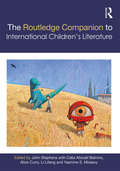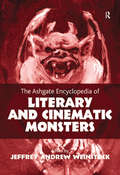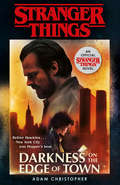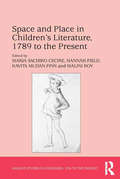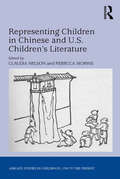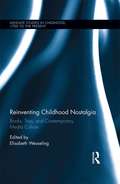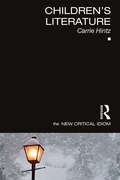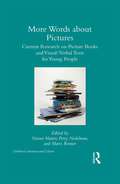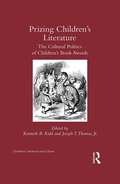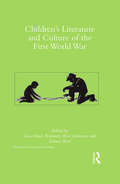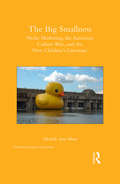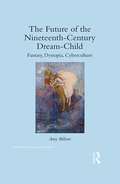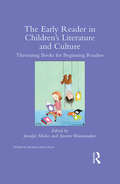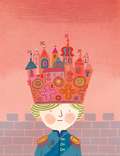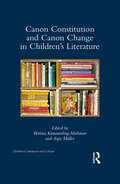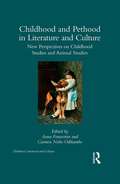- Table View
- List View
The Routledge Companion to International Children's Literature (Routledge Literature Companions)
by John Stephens Celia Abicalil Belmiro Alice Curry Li Lifang Yasmine S. MotawyDemonstrating the aesthetic, cultural, political and intellectual diversity of children’s literature across the globe, The Routledge Companion to International Children’s Literature is the first volume of its kind to focus on the undervisited regions of the world. With particular focus on Asia, Africa and Latin America, the collection raises awareness of children’s literature and related media as they exist in large regions of the world to which ‘mainstream’ European and North American scholarship pays very little attention. Sections cover: • Concepts and theories • Historical contexts and national identity • Cultural forms and children’s texts • Traditional story and adaptation • Picture books across the majority world • Trends in children’s and young adult literatures. Exposition of the literary, cultural and historical contexts in which children’s literature is produced, together with an exploration of intersections between these literatures and more extensively researched areas, will enhance access and understanding for a large range of international readers. The essays offer an ideal introduction for those newly approaching literature for children in specific areas, looking for new insights and interdisciplinary perspectives, or interested in directions for future scholarship.
The Routledge Companion to International Children's Literature (Routledge Literature Companions)
by John StephensDemonstrating the aesthetic, cultural, political and intellectual diversity of children’s literature across the globe, The Routledge Companion to International Children’s Literature is the first volume of its kind to focus on the undervisited regions of the world. With particular focus on Asia, Africa and Latin America, the collection raises awareness of children’s literature and related media as they exist in large regions of the world to which ‘mainstream’ European and North American scholarship pays very little attention. Sections cover: • Concepts and theories • Historical contexts and national identity • Cultural forms and children’s texts • Traditional story and adaptation • Picture books across the majority world • Trends in children’s and young adult literatures. Exposition of the literary, cultural and historical contexts in which children’s literature is produced, together with an exploration of intersections between these literatures and more extensively researched areas, will enhance access and understanding for a large range of international readers. The essays offer an ideal introduction for those newly approaching literature for children in specific areas, looking for new insights and interdisciplinary perspectives, or interested in directions for future scholarship.
The Ashgate Encyclopedia of Literary and Cinematic Monsters
by Jeffrey Andrew WeinstockFrom vampires and demons to ghosts and zombies, interest in monsters in literature, film, and popular culture has never been stronger. This concise Encyclopedia provides scholars and students with a comprehensive and authoritative A-Z of monsters throughout the ages. It is the first major reference book on monsters for the scholarly market. Over 200 entries written by experts in the field are accompanied by an overview introduction by the editor. Generic entries such as 'ghost' and 'vampire' are cross-listed with important specific manifestations of that monster. In addition to monsters appearing in English-language literature and film, the Encyclopedia also includes significant monsters in Spanish, French, Italian, German, Russian, Indian, Chinese, Japanese, African and Middle Eastern traditions. Alphabetically organized, the entries each feature suggestions for further reading. The Ashgate Encyclopedia of Literary and Cinematic Monsters is an invaluable resource for all students and scholars and an essential addition to library reference shelves.
Stranger Things: The Second Official Novel (Stranger Things Ser.)
by Adam ChristopherChief Jim Hopper reveals long-awaited secrets to Eleven about his old life as a police detective in New York City, confronting his past before the events of the hit show Stranger Things. Christmas, Hawkins, 1984. All Chief Jim Hopper wants is to enjoy a quiet first Christmas with Eleven, but his adopted daughter has other plans. Over Hopper’s protests, she pulls a cardboard box marked “New York” out of the basement—and the tough questions begin. Why did Hopper leave Hawkins all those years ago? What does “Vietnam” mean? And why has he never talked about New York?Although he’d rather face a horde of demogorgons than talk about his own past, Hopper knows that he can’t deny the truth any longer. And so begins the story of the incident in New York—the last big case before everything changed…Summer, New York City, 1977. Hopper is starting over after returning home from Vietnam. A young daughter, a caring wife, and a new beat as an NYPD detective make it easy to slip back into life as a civilian. But after shadowy federal agents suddenly show and seize the files about a series of brutal, unsolved murders, Hopper takes matters into his own hands, risking everything to discover the truth.Soon Hopper is undercover among New York’s notorious street gangs. But just as he's about to crack the case, a blackout rolls across the boroughs, plunging Hopper into a darkness deeper than any he’s faced before.
Space and Place in Children’s Literature, 1789 to the Present (Studies in Childhood, 1700 to the Present)
by Maria Sachiko Cecire Hannah Field Malini RoyFocusing on questions of space and locale in children’s literature, this collection explores how metaphorical and physical space can create landscapes of power, knowledge, and identity in texts from the early nineteenth century to the present. The collection is comprised of four sections that take up the space between children and adults, the representation of 'real world' places, fantasy travel and locales, and the physical space of the children’s book-as-object. In their essays, the contributors analyze works from a range of sources and traditions by authors such as Sylvia Plath, Maria Edgeworth, Gloria Anzaldúa, Jenny Robson, C.S. Lewis, Elizabeth Knox, and Claude Ponti. While maintaining a focus on how location and spatiality aid in defining the child’s relationship to the world, the essays also address themes of borders, displacement, diaspora, exile, fantasy, gender, history, home-leaving and homecoming, hybridity, mapping, and metatextuality. With an epilogue by Philip Pullman in which he discusses his own relationship to image and locale, this collection is also a valuable resource for understanding the work of this celebrated author of children’s literature.
Representing Children in Chinese and U.S. Children's Literature (Studies in Childhood, 1700 to the Present)
by Rebecca Morris Claudia NelsonBringing together children’s literature scholars from China and the United States, this collection provides an introduction to the scope and goals of a field characterized by active but also distinctive scholarship in two countries with very different rhetorical traditions. The volume’s five sections highlight the differences between and overlapping concerns of Chinese and American scholars, as they examine children’s literature with respect to cultural metaphors and motifs, historical movements, authorship, didacticism, important themes, and the current status of and future directions for literature and criticism. Wide-ranging and admirably ambitious in its encouragement of communication between scholars from two major nations, Representing Children in Chinese and U.S. Children’s Literature serves as a model for examining how and why children’s literature, more than many literary forms, circulates internationally.
Reinventing Childhood Nostalgia: Books, Toys, and Contemporary Media Culture (Studies in Childhood, 1700 to the Present)
by Elisabeth WesselingWhile Romantic-era concepts of childhood nostalgia have been understood as the desire to retrieve the ephemeral mindset of the child, this collection proposes that the emergence of digital media has altered this reflective gesture towards the past. No longer is childhood nostalgia reliant on individual memory. Rather, it is associated through contemporary convergence culture with the commodities of one's youth as they are recycled from one media platform to another. Essays in the volume's first section identify recurrent patterns in the recycling, adaptation, and remediation of children's toys and media, providing context for section two's exploration of childhood nostalgia in memorial practices. In these essays, the contributors suggest that childhood toys and media play a role in the construction of s the imagined communities (Benedict Anderson) that define nations and nationalism. Eschewing the dichotomy between restorative and reflexive nostalgia, the essays in section three address the ethics of nostalgia in terms of child agency and depictions of childhood. In a departure from the notion that childhood nostalgia is the exclusive prerogative of narrative fiction, section four looks for its traces in the child sciences. Pushing against nostalgia's persistent associations with wishful thinking, false memories, and distortion, this collection suggests nostalgia is never categorically good or bad in itself, but owes its benefits or defects to the ways in which it is brought to bear on the representation of children and childhood.
Reinventing Childhood Nostalgia: Books, Toys, and Contemporary Media Culture (Studies in Childhood, 1700 to the Present)
by Elisabeth WesselingWhile Romantic-era concepts of childhood nostalgia have been understood as the desire to retrieve the ephemeral mindset of the child, this collection proposes that the emergence of digital media has altered this reflective gesture towards the past. No longer is childhood nostalgia reliant on individual memory. Rather, it is associated through contemporary convergence culture with the commodities of one's youth as they are recycled from one media platform to another. Essays in the volume's first section identify recurrent patterns in the recycling, adaptation, and remediation of children's toys and media, providing context for section two's exploration of childhood nostalgia in memorial practices. In these essays, the contributors suggest that childhood toys and media play a role in the construction of s the imagined communities (Benedict Anderson) that define nations and nationalism. Eschewing the dichotomy between restorative and reflexive nostalgia, the essays in section three address the ethics of nostalgia in terms of child agency and depictions of childhood. In a departure from the notion that childhood nostalgia is the exclusive prerogative of narrative fiction, section four looks for its traces in the child sciences. Pushing against nostalgia's persistent associations with wishful thinking, false memories, and distortion, this collection suggests nostalgia is never categorically good or bad in itself, but owes its benefits or defects to the ways in which it is brought to bear on the representation of children and childhood.
Children's Literature (The New Critical Idiom)
by Carrie HintzChildren’s Literature is an accessible introduction to this engaging field. Carrie Hintz offers a defining conceptual overview of children’s literature that presents its competing histories, its cultural contexts, and the theoretical debates it has instigated. Positioned within the wider field of adult literary, film, and television culture, this book also covers: Ideological and political movements Children’s literature in the age of globalization Postcolonial literature, ecocriticism, and animal studies Each chapter includes a case study featuring well-known authors and titles, including Charlotte’s Web, Edward Lear, and Laura Ingalls Wilder. With a comprehensive glossary and further reading, this book is invaluable reading for anyone studying Children’s Literature.
Children's Literature (The New Critical Idiom)
by Carrie HintzChildren’s Literature is an accessible introduction to this engaging field. Carrie Hintz offers a defining conceptual overview of children’s literature that presents its competing histories, its cultural contexts, and the theoretical debates it has instigated. Positioned within the wider field of adult literary, film, and television culture, this book also covers: Ideological and political movements Children’s literature in the age of globalization Postcolonial literature, ecocriticism, and animal studies Each chapter includes a case study featuring well-known authors and titles, including Charlotte’s Web, Edward Lear, and Laura Ingalls Wilder. With a comprehensive glossary and further reading, this book is invaluable reading for anyone studying Children’s Literature.
More Words about Pictures: Current Research on Picturebooks and Visual/Verbal Texts for Young People (Children's Literature and Culture)
by Naomi Hamer Perry Nodelman Mavis ReimerThis volume represents the current state of research on picture books and other adjacent hybrid forms of visual/verbal texts such as comics, graphic novels, and book apps, with a particular focus on texts produced for and about young people. When Perry Nodelman’s Words about Pictures: the Narrative Art of Children’s Picture Books was published almost three decades ago, it was greeted as an important contribution to studies in children’s picture books and illustration internationally; and based substantially on it, Nodelman has recently been named the 2015 recipient of the International Grimm Award for children’s literature criticism. In the years since Words About Pictures appeared, scholars have built on Nodelman’s groundbreaking text and have developed a range of other approaches, both to picture books and to newer forms of visual/verbal texts that have entered the marketplace and become popular with young people. The essays in this book offer 'more words' about established and emerging forms of picture books, providing an overview of the current state of studies in visual/verbal texts and gathering in one place the work being produced at various locations and across disciplines. Essays exploring areas such as semiological and structural aspects of conventional picture books, graphic narratives and new media forms, and the material and performative cultures of picture books represent current work not only from literary studies but also media studies, art history, ecology, Middle Eastern Studies, library and information studies, and educational research. In addition to work by international scholars including William Moebius, Erica Hateley, Nathalie op de Beeck, and Nina Christensen that carries on and challenges the conclusions of Words about Pictures, the collection also includes a wide-ranging reflection by Perry Nodelman on continuities and changes in the current interdisciplinary field of study of visual/verbal texts for young readers. Providing a look back over the history of picture books and the development of picture book scholarship, More Words About Pictures also offers an overview of our current understanding of these intriguing texts.
More Words about Pictures: Current Research on Picturebooks and Visual/Verbal Texts for Young People (Children's Literature and Culture)
by Perry Nodelman Naomi Hamer Mavis ReimerThis volume represents the current state of research on picture books and other adjacent hybrid forms of visual/verbal texts such as comics, graphic novels, and book apps, with a particular focus on texts produced for and about young people. When Perry Nodelman’s Words about Pictures: the Narrative Art of Children’s Picture Books was published almost three decades ago, it was greeted as an important contribution to studies in children’s picture books and illustration internationally; and based substantially on it, Nodelman has recently been named the 2015 recipient of the International Grimm Award for children’s literature criticism. In the years since Words About Pictures appeared, scholars have built on Nodelman’s groundbreaking text and have developed a range of other approaches, both to picture books and to newer forms of visual/verbal texts that have entered the marketplace and become popular with young people. The essays in this book offer 'more words' about established and emerging forms of picture books, providing an overview of the current state of studies in visual/verbal texts and gathering in one place the work being produced at various locations and across disciplines. Essays exploring areas such as semiological and structural aspects of conventional picture books, graphic narratives and new media forms, and the material and performative cultures of picture books represent current work not only from literary studies but also media studies, art history, ecology, Middle Eastern Studies, library and information studies, and educational research. In addition to work by international scholars including William Moebius, Erica Hateley, Nathalie op de Beeck, and Nina Christensen that carries on and challenges the conclusions of Words about Pictures, the collection also includes a wide-ranging reflection by Perry Nodelman on continuities and changes in the current interdisciplinary field of study of visual/verbal texts for young readers. Providing a look back over the history of picture books and the development of picture book scholarship, More Words About Pictures also offers an overview of our current understanding of these intriguing texts.
Prizing Children's Literature: The Cultural Politics of Children’s Book Awards (Children's Literature and Culture)
by Kenneth B. Kidd Joseph T. ThomasChildren's book awards have mushroomed since the early twentieth-century and especially since the 1960s, when literary prizing became a favored strategy for both commercial promotion and canon-making. There are over 300 awards for English-language titles alone, but despite the profound impact of children’s book awards, scholars have paid relatively little attention to them. This book is the first scholarly volume devoted to the analysis of Anglophone children's book awards in historical and cultural context. With attention to both political and aesthetic concerns, the book offers original and diverse scholarship on prizing practices and their consequences in Australia, Canada, and especially the United States. Contributors offer both case studies of particular awards and analysis of broader trends in literary evaluation and elevation, drawing on theoretical work on canonization and cultural capital. Sections interrogate the complex and often unconscious ideological work of prizing, the ongoing tension between formalist awards and so-called identity-based awards — all the more urgent in light of the "We Need Diverse Books" campaign — the ever-morphing forms and parameters of prizing, and scholarly practices of prizing. Among the many awards discussed are the Pura Belpré Medal, the Inky Awards, the Canada Governor General Literary Award, the Printz Award, the Best Animated Feature Oscar, the Phoenix Award, and the John Newbery Medal, giving due attention to prizes for fiction as well as for non-fiction, poetry, and film. This volume will interest scholars in literary and cultural studies, social history, book history, sociology, education, library and information science, and anyone concerned with children's literature.
Prizing Children's Literature: The Cultural Politics of Children’s Book Awards (Children's Literature and Culture)
Children's book awards have mushroomed since the early twentieth-century and especially since the 1960s, when literary prizing became a favored strategy for both commercial promotion and canon-making. There are over 300 awards for English-language titles alone, but despite the profound impact of children’s book awards, scholars have paid relatively little attention to them. This book is the first scholarly volume devoted to the analysis of Anglophone children's book awards in historical and cultural context. With attention to both political and aesthetic concerns, the book offers original and diverse scholarship on prizing practices and their consequences in Australia, Canada, and especially the United States. Contributors offer both case studies of particular awards and analysis of broader trends in literary evaluation and elevation, drawing on theoretical work on canonization and cultural capital. Sections interrogate the complex and often unconscious ideological work of prizing, the ongoing tension between formalist awards and so-called identity-based awards — all the more urgent in light of the "We Need Diverse Books" campaign — the ever-morphing forms and parameters of prizing, and scholarly practices of prizing. Among the many awards discussed are the Pura Belpré Medal, the Inky Awards, the Canada Governor General Literary Award, the Printz Award, the Best Animated Feature Oscar, the Phoenix Award, and the John Newbery Medal, giving due attention to prizes for fiction as well as for non-fiction, poetry, and film. This volume will interest scholars in literary and cultural studies, social history, book history, sociology, education, library and information science, and anyone concerned with children's literature.
Children's Literature and Culture of the First World War (Children's Literature and Culture)
by Emma Short Lissa Paul Rosemary R. JohnstonBecause all wars in the twenty-first century are potentially global wars, the centenary of the first global war is the occasion for reflection. This volume offers an unprecedented account of the lives, stories, letters, games, schools, institutions (such as the Boy Scouts and YMCA), and toys of children in Europe, North America, and the Global South during the First World War and surrounding years. By engaging with developments in Children’s Literature, War Studies, and Education, and mining newly available archival resources (including letters written by children), the contributors to this volume demonstrate how perceptions of childhood changed in the period. Children who had been constructed as Romantic innocents playing safely in secure gardens were transformed into socially responsible children actively committing themselves to the war effort. In order to foreground cross-cultural connections across what had been perceived as ‘enemy’ lines, perspectives on German, American, British, Australian, and Canadian children’s literature and culture are situated so that they work in conversation with each other. The multidisciplinary, multinational range of contributors to this volume make it distinctive and a particularly valuable contribution to emerging studies on the impact of war on the lives of children.
The Big Smallness: Niche Marketing, the American Culture Wars, and the New Children’s Literature (Children's Literature and Culture)
by Michelle Ann AbateThis book is the first full-length critical study to explore the rapidly growing cadre of amateur-authored, independently-published, and niche-market picture books that have been released during the opening decades of the twenty-first century. Emerging from a powerful combination of the ease and affordability of desktop publishing software; the promotional, marketing, and distribution possibilities allowed by the Internet; and the tremendous national divisiveness over contentious socio-political issues, these texts embody a shift in how narratives for young people are being creatively conceived, materially constructed, and socially consumed in the United States. Abate explores how titles such as My Parents Open Carry (about gun laws), It’s Just a Plant (about marijuana policy), and My Beautiful Mommy (about the plastic surgery industry) occupy important battle stations in ongoing partisan conflicts, while they are simultaneously changing the landscape of American children’s literature. The book demonstrates how texts like Little Zizi and Me Tarzan, You Jane mark the advent of not simply a new commercial strategy in texts for young readers; they embody a paradigm shift in the way that narratives are being conceived, constructed, and consumed. Niche market picture books can be seen as a telling barometer about public perceptions concerning children and the social construction of childhood, as well as the function of narratives for young readers in the twenty-first century. At the same time, these texts reveal compelling new insights about the complex interaction among American print culture, children’s reading practices, and consumer capitalism. Amateur-authored, self-published, and specialty-subject titles reveal the way in which children, childhood, and children’s literature are both highly political and heavily politicized in the United States. The book will be of interest to scholars and students in the fields of American Studies, children’s literature, childhood studies, popular culture, political science, microeconomics, psychology, advertising, book history, education, and gender studies.
The Future of the Nineteenth-Century Dream-Child: Fantasy, Dystopia, Cyberculture (Children's Literature and Culture)
by Amy BilloneThis book investigates the reappearance of the 19th-century dream-child from the Golden Age of Children's Literature, both in the Harry Potter series and in other works that have reached unprecedented levels of popular success today. Discussing Harry Potter as a reincarnation of Lewis Carroll's Alice and J.M. Barrie's Peter Pan, Billone goes on to examine the recent resurrection of Alice in Tim Burton's Alice, and of Peter Pan in Michael Jackson and in James Bond. Visiting trends that have emerged since the Harry Potter series ended, the book studies revisions of the dream-child in texts and films that have inspired mass fandom in the twenty-first century: Stephenie Meyer's Twilight, E.L. James's 50 Shades of Grey and Suzanne Collins's The Hunger Games. The volume argues that the 21st-century desire to achieve dream-states in relationship to eternal youth results from the way that dreams provide a means of realizing the fantastic yet alarming possibility of escaping from time. This current identification with the dream-child stems from the threat of political unrest and economic and environmental collapse as well as from the simultaneous technophilia and technophobia of a culture immersed in the breathless revolution of the digital age. This book not only explores how the dream-child from the past has returned to reflect misgivings about imagined dystopian futures but also reveals how the rebirth of the dream-child opens up possibilities for new narratives where happy endings remain viable against all odds. It will appeal to scholars in a wide variety of fields including Childhood Studies, Children's/YA Literature, Cinema Studies, Cultural Studies, Cyberculture, Gender Studies, Queer Studies, Gothic Studies, New Media, and Popular Culture.
The Early Reader in Children's Literature and Culture: Theorizing Books for Beginning Readers (Children's Literature and Culture)
by Jennifer Miskec Annette WannamakerThis is the first volume to consider the popular literary category of Early Readers – books written and designed for children who are just beginning to read independently. It argues that Early Readers deserve more scholarly attention and careful thought because they are, for many younger readers, their first opportunity to engage with a work of literature on their own, to feel a sense of mastery over a text, and to experience pleasure from the act of reading independently. Using interdisciplinary approaches that draw upon and synthesize research being done in education, child psychology, sociology, cultural studies, and children’s literature, the volume visits Early Readers from a variety of angles: as teaching tools; as cultural artifacts that shape cultural and individual subjectivity; as mass produced products sold to a niche market of parents, educators, and young children; and as aesthetic objects, works of literature and art with specific conventions. Examining the reasons such books are so popular with young readers, as well as the reasons that some adults challenge and censor them, the volume considers the ways Early Readers contribute to the construction of younger children as readers, thinkers, consumers, and as gendered, raced, classed subjects. It also addresses children’s texts that have been translated and sold around the globe, examining them as part of an increasingly transnational children’s media culture that may add to or supplant regional, ethnic, and national children’s literatures and cultures. While this collection focuses mostly on books written in English and often aimed at children living in the US, it is important to acknowledge that these Early Readers are a major US cultural export, influencing the reading habits and development of children across the globe.
Child Autonomy and Child Governance in Children's Literature: Where Children Rule (Children's Literature and Culture)
by Christopher KelenThis book explores representations of child autonomy and self-governance in children’s literature.The idea of child rule and child realms is central to children’s literature, and childhood is frequently represented as a state of being, with children seen as aliens in need of passports to Adultland (and vice versa). In a sense all children’s literature depends on the idea that children are different, separate, and in command of their own imaginative spaces and places. Although the idea of child rule is a persistent theme in discussions of children’s literature (or about children and childhood) the metaphor itself has never been properly unpacked with critical reference to examples from those many texts that are contingent on the authority and/or power of children. Child governance and autonomy can be seen as natural or perverse; it can be displayed as a threat or as a promise. Accordingly, the "child rule"-motif can be seen in Robinsonades and horror films, in philosophical treatises and in series fiction. The representations of self-ruling children are manifold and ambivalent, and range from the idyllic to the nightmarish. Contributors to this volume visit a range of texts in which children are, in various ways, empowered, discussing whether childhood itself may be thought of as a nationality, and what that may imply. This collection shows how representations of child governance have been used for different ideological, aesthetic, and pedagogical reasons, and will appeal to scholars of children’s literature, childhood studies, and cultural studies.
Child Autonomy and Child Governance in Children's Literature: Where Children Rule (Children's Literature and Culture)
by Christopher Kelen Bjorn SundmarkThis book explores representations of child autonomy and self-governance in children’s literature.The idea of child rule and child realms is central to children’s literature, and childhood is frequently represented as a state of being, with children seen as aliens in need of passports to Adultland (and vice versa). In a sense all children’s literature depends on the idea that children are different, separate, and in command of their own imaginative spaces and places. Although the idea of child rule is a persistent theme in discussions of children’s literature (or about children and childhood) the metaphor itself has never been properly unpacked with critical reference to examples from those many texts that are contingent on the authority and/or power of children. Child governance and autonomy can be seen as natural or perverse; it can be displayed as a threat or as a promise. Accordingly, the "child rule"-motif can be seen in Robinsonades and horror films, in philosophical treatises and in series fiction. The representations of self-ruling children are manifold and ambivalent, and range from the idyllic to the nightmarish. Contributors to this volume visit a range of texts in which children are, in various ways, empowered, discussing whether childhood itself may be thought of as a nationality, and what that may imply. This collection shows how representations of child governance have been used for different ideological, aesthetic, and pedagogical reasons, and will appeal to scholars of children’s literature, childhood studies, and cultural studies.
Canon Constitution and Canon Change in Children's Literature (Children's Literature and Culture)
by Bettina Kümmerling-Meibauer Anja MüllerThis volume focuses on the (de)canonization processes in children’s literature, considering the construction and cultural-historical changes of canons in different children’s literatures. Chapters by international experts in the field explore a wide range of different children’s literatures from Great Britain, Germany, Scandinavia, the Low Countries, Eastern and Central Europe, as well as from Non-European countries such as Australia, Israel, and the United States. Situating the inquiry within larger literary and cultural studies conversations about canonicity, the contributors assess representative authors and works that have encountered changing fates in the course of canon history. Particular emphasis is given to sociological canon theories, which have so far been under-represented in canon research in children’s literature. The volume therefore relates historical changes in the canon of children’s literature not only to historical changes in concepts of childhood but to more encompassing political, social, economic, cultural, and ideological shifts. This volume’s comparative approach takes cognizance of the fact that, if canon formation is an important cultural factor in nation-building processes, a comparative study is essential to assessing transnational processes in canon formation. This book thus renders evident the structural similarities between patterns and strategies of canon formation emerging in different children’s literatures.
Canon Constitution and Canon Change in Children's Literature (Children's Literature and Culture)
This volume focuses on the (de)canonization processes in children’s literature, considering the construction and cultural-historical changes of canons in different children’s literatures. Chapters by international experts in the field explore a wide range of different children’s literatures from Great Britain, Germany, Scandinavia, the Low Countries, Eastern and Central Europe, as well as from Non-European countries such as Australia, Israel, and the United States. Situating the inquiry within larger literary and cultural studies conversations about canonicity, the contributors assess representative authors and works that have encountered changing fates in the course of canon history. Particular emphasis is given to sociological canon theories, which have so far been under-represented in canon research in children’s literature. The volume therefore relates historical changes in the canon of children’s literature not only to historical changes in concepts of childhood but to more encompassing political, social, economic, cultural, and ideological shifts. This volume’s comparative approach takes cognizance of the fact that, if canon formation is an important cultural factor in nation-building processes, a comparative study is essential to assessing transnational processes in canon formation. This book thus renders evident the structural similarities between patterns and strategies of canon formation emerging in different children’s literatures.
The Kissing Booth: World Book Day 2020 (The Kissing Booth)
by Beth ReeklesA super-fun romantic comedy short story, set in the world of the bestselling The Kissing Booth - written exclusively for World Book Day 2020!Everyone knows it's TOUGH having a long-distance relationship - especially when your boyfriend is as sizzlingly hot and exciting as Noah Flynn. Elle's thrilled her bad-boy-turned good has made it into Harvard, but being stuck back in Los Angeles isn't much fun without him. So there's only one thing for it . . . a road trip to visit! And what could be better than packing up your best buddy's convertible sports car, heading out on Route 66, and looking for fun and adventure along the way? Maybe only the person waiting for you at the other end . . .
Childhood and Pethood in Literature and Culture: New Perspectives in Childhood Studies and Animal Studies (Children's Literature and Culture)
by Anna Feuerstein Carmen Nolte-OdhiamboBringing together new perspectives in childhood studies and animal studies, this book is the first collection to critically address the manifold alignments and frequent co-constitutions of children and pets in our families, our cultures, and our societies. The cultural politics of power shaping relationships between children, pets, and adults inform the wide range of essays included in this collection, as they explore issues such as protection, discipline, mastery, wildness, play, and domestication. The volume use the frequent social and cultural intersections between children and pets as an opportunity to analyze institutions that create pet and child subjectivity, from education and training to putting children and pets on display for entertainment purposes. Essays analyze legal discourses, visual culture, literature for children and adults, migration narratives, magazines for children, music, and language socialization to discuss how notions of nationalism, race, gender, heteronormativity, and speciesism shape cultural constructions of children and pets. Examining childhood and pethood in America, Europe, Asia, and the Pacific, this collection shows how discourses linking children and pets are pervasive and work across cultures. By presenting innovative approaches to the child and the pet, the book brings to light alternative paths toward understanding these figures, leading to new openings and questions about kinship, agency, and the power of care that so often shapes our relationships with children and animals. This will be an important volume for scholars of animal studies, childhood studies, children’s literature, cultural studies, political theory, education, art history, and sociology.
Childhood and Pethood in Literature and Culture: New Perspectives in Childhood Studies and Animal Studies (Children's Literature and Culture)
by Anna Feuerstein Carmen Nolte-OdhiamboBringing together new perspectives in childhood studies and animal studies, this book is the first collection to critically address the manifold alignments and frequent co-constitutions of children and pets in our families, our cultures, and our societies. The cultural politics of power shaping relationships between children, pets, and adults inform the wide range of essays included in this collection, as they explore issues such as protection, discipline, mastery, wildness, play, and domestication. The volume use the frequent social and cultural intersections between children and pets as an opportunity to analyze institutions that create pet and child subjectivity, from education and training to putting children and pets on display for entertainment purposes. Essays analyze legal discourses, visual culture, literature for children and adults, migration narratives, magazines for children, music, and language socialization to discuss how notions of nationalism, race, gender, heteronormativity, and speciesism shape cultural constructions of children and pets. Examining childhood and pethood in America, Europe, Asia, and the Pacific, this collection shows how discourses linking children and pets are pervasive and work across cultures. By presenting innovative approaches to the child and the pet, the book brings to light alternative paths toward understanding these figures, leading to new openings and questions about kinship, agency, and the power of care that so often shapes our relationships with children and animals. This will be an important volume for scholars of animal studies, childhood studies, children’s literature, cultural studies, political theory, education, art history, and sociology.
